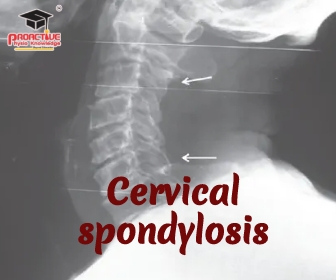Cervical Spondylosis
Cervical spondylosis comprises a broad spectrum of progressive degenerative alterations that affect all cervical spine components (i.e., intervertebral discs, facet joints, joints of the Luschka, ligaments flava, and laminae). It is a normal part of the aging process and occurs in the majority of individuals after the fifth decade. This chronic degenerative process in the cervical spine affects the intervertebral discs and facet joints and may develop into disc herniation, osteophyte formation, vertebral body degeneration, spinal cord compression, or cervical spondylotic myelopathy. When neural structures are compressed, cervical spondylosis manifests as neck pain and stiffness, which may be accompanied by radicular symptoms. Neck discomfort is a frequent complaint, second only to low back pain in the frequency of occurrence. This disorder is linked with a large burden of sickness, disability, and economic cost. Although aging is the major cause the location and pace of degeneration, as well as the severity of symptoms and functional impairment, vary from person to person.
Epidemiology
Evidence of spondylotic change is frequently found in many asymptomatic adults, with evidence of some disc degeneration in:
- 25% of adults under the age of 40,
- 50% of adults over the age of 40, and
- 85% of adults over the age of 60
Asymptomatic adults showed significant degenerative changes at 1 or more levels
- 70% of women and 95% of men at age 65 and 60 were affected
- The most common evidence of degeneration is found at C5-6 followed by C6-7 and C4-5″.
Risk Factor
- Age, gender and occupation.
- The prevalence of cervical spondylosis is similar for both sexes, although the degree of severity is greater for males.
- Repeated occupational trauma may contribute to the development of cervical spondylosis.
- Increased incidence in patients who carried heavy loads on their heads or shoulders and in dancers and gymnasts.
- In about 10% of patients, cervical spondylosis is due to congenital bony anomalies, blocked vertebrae, malformed laminae that place undue stress on adjacent intervertebral discs.
Clinical presentation
1 Non-specific neck discomfort – spinal column-localized pain
2 Cervical radiculopathy – symptoms with a dermatomal or myotomal distribution, which are often experienced in the arms. There may be numbness, discomfort, or function loss.
3 Cervical myelopathy – a collection of symptoms and results resulting from intrinsic spinal cord injury. With concomitant physical findings, numbness, coordination and gait problems, grip weakness, and bowel and bladder symptoms may be observed.
Depending on the stage of the disease process and the place of neurological compression, symptoms might vary. The patient may be asymptomatic despite the presence of spondylosis on imaging[10], and vice versa. On radiographs of the cervical spine, many individuals over the age of 30 have comparable anomalies, making it difficult to distinguish between normal aging and disease.
Pain is the symptom most often mentioned. According to McCormack et al. intermittent neck and shoulder pain is the most prevalent symptom seen in clinical practice. Pain most often occurs in the cervical area, upper extremity, shoulder, and/or interscapular region with cervical radiculopathy. In certain circumstances, the pain may be unusual and appear as chest or breast discomfort, however, it is most often experienced in the upper extremities and neck. Chronic suboccipital headache may be a clinical condition in individuals with cervical spondylosis, which may radiate to the base of the neck and the top of the head.
Frequently reported symptoms of paraesthesia, muscular weakness, or a combination thereof, suggest radiculopathy.
In certain instances, dysphagia or airway dysfunction has been described in association with central cord syndrome and cervical spondylosis.
Examination
This content is private. please select our membership plan to unlock the private content features.
Click here
And unlock the content.



